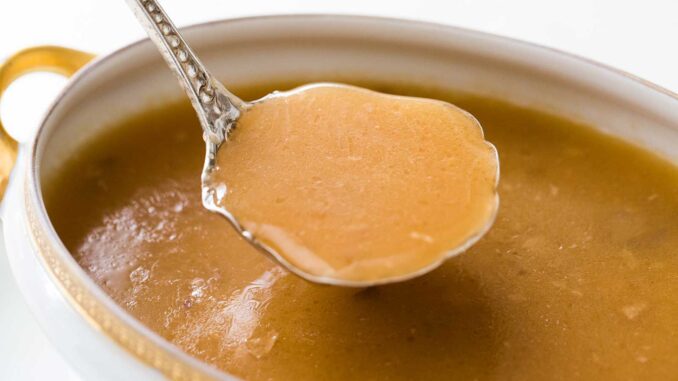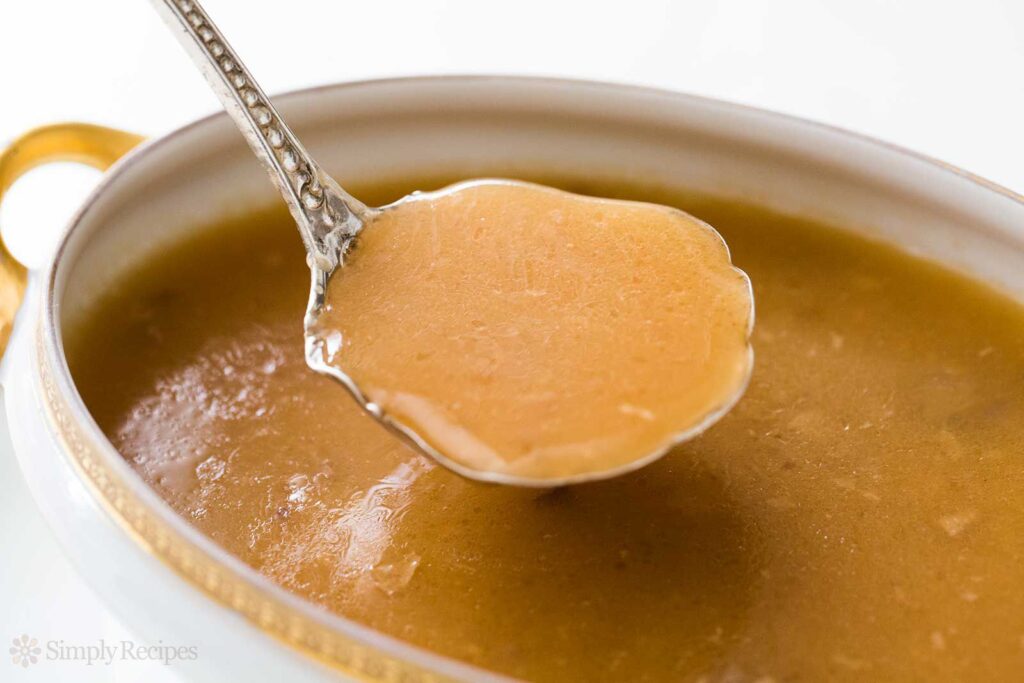

gravy
音标:
英音/ ˈɡreɪvi / 美音/ ˈɡreɪvi /
听听基本释意:
外刊例句:
Boudin blanc creamy white sausage and chicken mince flavoured with truffle, nutmeg and thyme served with stomp, a mashed potato of leaks, carrots and bacon, beer braised chicory and an onion and Belgian beer gravy.
Boudin blanc 奶油白香肠和鸡肉末,以松露、肉豆蔻和百里香调味,搭配跺脚、土豆泥、胡萝卜和培根、啤酒炖菊苣、洋葱和比利时啤酒肉汁。
—BBC
About those candy canes: The company also stocks them in the following flavors: macaroni and cheese, pickle, ketchup, gravy, hot dog, Caesar salad, butter and sardine.
关于这些拐杖糖:该公司还库存以下口味的拐杖糖:通心粉和奶酪、泡菜、番茄酱、肉汁、热狗、凯撒沙拉、黄油和沙丁鱼。
—Washington Times
The two families both say that it was their own Kundan who invented butter chicken — the creamy, heavenly marriage of tandoori chicken and tomato gravy beloved everywhere north Indian food is served.
这两个家族都说,是他们自己的昆丹发明了黄油鸡——坦杜里鸡和番茄肉汁的奶油般的天堂般的结合,在北印度美食的任何地方都受到人们的喜爱。
—New York Times
基本释意:
noun
a sauce made by adding stock, flour, or other ingredients to the juice and fat that drips from cooking meats
肉汁;不法利润;轻易得来的钱
同义词:
没有找到同义词
短释义:
无
长释义:
无
文学例句:
“Gross but delicious,” Malcolm says, licking gravy off of the spork.
“恶心但美味,”马尔科姆一边说,一边舔掉叉勺上的肉汁。
—A Heart in a Body in the World by Deb Caletti
The steam is still rising from the gravy—it’s not brown Jell-O yet.
蒸汽仍在从肉汁中升起——它还不是棕色的果冻。
—Everything Sad Is Untrue by Daniel Nayeri
“That wasn’t gravy, Petunia, that was…Oh, never mind!”
“那不是肉汁,佩妮,那是……哦,没关系!”
—Dog Squad by Chris Grabenstein
词源:
gravy (n.)late 14c. (perhaps mid-13c. in Anglo-French), grave, gravei, gravi, greve, gravey, gravee, grovi, grauvey, with u/v interchange being typical of medieval spelling. From Old French gravé, graué, “seasoned broth or sauce.” Originally a spiced stew, it became popular in Europe in the 14th century.
Compare Persian zirbaja, said by H.F. Amedroz to mean “concoction in a pot.” The unattested intermediate term should have been something like *girveie (see evolution of ginger for comparison.)
Recipe for Zîrbâja […] Take a young, cleaned hen and put it in a pot with a little salt, pepper, coriander, cinnamon, saffron and sufficient of vinegar and fresh oil, and when the meat is cooked, take peeled, crushed almonds and good white sugar, four ûqiyas of each; dissolve them in rosewater, pour in the pot and let it boil; then leave it on the embers until the fat rises. It is the most nutritious of dishes and good for all temperaments; this dish is made with hens or pigeons or doves, or with the meat of a young lamb. [
An Anonymous Andalusian Cookbook of the 13th Century, translated by Charles Perry.]
Conyngys in graueye. Take Conyngys, and make hem clene, and hakke hem in gobettys, and sethe hem, other larde hem and Rost hem; and thanne hakke hem, and take Almaundys, and grynde hem, and temper hem vppe with gode Freysshe brothe of Flesshe, and coloure it wyth Safroun, and do ther-to a porcyon of flowre of Rys, and do ther-to then pouder Gyngere, Galyngale, Canel, Sugre, Clowys, Maces, and boyle it onys and sethe it; then take the Conyngys, and putte ther-on, and dresse it and serue it forth. [Harleian MS 279, date ca. 1420]
A claim that traces to Frédéric Godefroy in 19c. is that gravé is a non-word created as a persistent mistranscription of grané, but Godefroy adjusted the spellings of his citations to match his theory. Grané is a similar soup mixture with which gravé is indeed conflated in French manuscripts, but which does not appear in English cookery. It is usually supposed to be from Medieval Latin granatum “corned, grained.”
There may have been a second word, combined through folk-etymology, that led to gravé’s secondary sense of “juice of cooked meat.” Perhaps Old French engravee “carved, sliced” or Old English greofa, an oil-pan (related to greaves, 1610s, “fibrous matter cooked out of animal fat.”) The sense of broths or drippings appears to originally be of fishes, then soon extended to meat drippings or gelatin, which sense grows dominant in English from mid-15c, though still used most typically of fish or other seafood till 16c.
As “a sauce made with meat drippings,” 1670s, originally sauce gravy or gravy sauce. Applied to vegetarian mixtures by 1875. The meaning “tomato sauce” (chiefly Italian-American) is by 1978, evidently from certain Italian dialects differentiating tomato puree (salsa, “sauce”) from the cooked tomato sauce (sugo, translated “gravy” in many 19c. and 20c. Italian-English dictionaries.)
The meaning “money easily acquired” is attested by 1910; gravy train (by 1899) as something lucrative or productive is said to have been originally railroad slang for a short haul that paid well. Gravy-boat “small, deep dish for holding gravy or sauce” is from 1827.Related entries & more
下面是词源的翻译(机器翻译比较难翻,参考着看)
肉汁(n.)晚14c。 (可能是 13 世纪中期的英法语)grave、gravei、gravi、greve、gravey、gravee、grovi、gravey,u/v 互换是典型的中世纪拼写。源自古法语 gravé、graué,“调味肉汤或酱汁”。它最初是一种五香炖菜,14世纪在欧洲流行起来。比较一下波斯语 zirbaja,HF Amedroz 说它的意思是“锅里的混合物”。未经证实的中间术语应该类似于*girveie(参见生姜的演变进行比较。) Zîrbâja 的食谱 […] 取一只年轻的、干净的母鸡,将其放入锅中,加入少许盐、胡椒、香菜、肉桂、藏红花醋、鲜油足量,肉熟时,取去皮捣碎的杏仁,上好的白糖,各四乌其亚。将它们溶解在玫瑰水中,倒入锅中煮沸;然后将其放在余烬上,直到脂肪升起。它是菜肴中最有营养、最适合各种气质的菜肴;这道菜是用母鸡、鸽子或鸽子或小羔羊的肉制成的。 [ 13 世纪安达卢西亚匿名食谱,查尔斯·佩里 (Charles Perry) 翻译。] 灰褐色 Conyngys。采用Conyngys,使下摆干净,并在gobettys中制作hakke下摆,并设置下摆,其他larde下摆和Rost下摆;和thanne hakke下摆,并采取Almaundys,和grynde下摆,并用Flesshe的Gode Freysshe兄弟调和,用Safroun着色,然后对Rys的porcyon进行处理,然后对Gyngere进行pouder Gyngere 、Galyngale、Canel、Sugre、Clowys、Maces 和 boyle it onys 并设置它;然后拿起Conyngys,穿上它,穿好衣服,然后把它送出去。 [Harleian MS 279,日期约。 1420] 一个可以追溯到 19c 的 Frédéric Godefroy 的主张。 gravé 是一个非单词,是由于 grané 的持续错误转录而创建的,但戈德弗罗伊调整了引文的拼写以符合他的理论。 Grané 是一种类似的汤混合物,在法国手稿中确实与 gravé 混为一谈,但在英国烹饪中却没有出现。它通常被认为来自中世纪拉丁语 granatum“玉米,粒状”。可能还有第二个词,通过民间词源学组合而成,导致了gravé的次要含义“熟肉汁”。也许是古法语 engravee“雕刻、切片”或古英语 greofa,一个油锅(与 greaves 有关,1610 年代,“用动物脂肪烹制的纤维物质。”)肉汤或滴水的感觉最初似乎是鱼的,然后很快扩展到肉汁或明胶,从 15 世纪中期开始,这种含义在英语中占据主导地位,但直到 16 世纪仍然最常用于鱼或其他海鲜。 1670年代为“用肉滴制成的酱汁”,原意为酱汁肉汁或肉汁酱。 1875 年应用于素食混合物。到 1978 年,“番茄酱”(主要是意大利裔美国人)的含义出现,显然来自某些意大利方言,用于区分番茄酱(萨尔萨酱,“酱汁”)和煮熟的番茄酱(sugo,翻译为“肉汁”)在许多 19 世纪和 20 世纪的意大利语-英语词典中。)“金钱容易获得”的含义在 1910 年得到证实; gravy train(1899 年)作为一种有利可图或富有成效的东西,据说最初是铁路俚语,指报酬丰厚的短途运输。肉汁船“用于盛肉汁或酱汁的小而深的盘子”来自 1827 年。相关条目及更多
本站没有存储任何书籍、杂志和报纸。
页面内容只做展示和推荐。如果您喜欢本期内容请购买正版。
This site does not store any books, magazines or newspapers.
The contents of the pages are for display and recommendation only.
If you like the content of this issue please purchase the original.